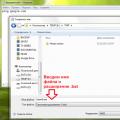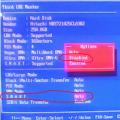Today I would like to tell you about the Terminix terminal emulator, which is often mentioned by readers of our site.
It's worth noting that today I don't live in a terminal: I regularly use apt, snap and a few others console utilities and sometimes I work with the git version control system. Therefore, at least for my needs, it is enough to use GNOME Terminal, the standard terminal emulator in Ubuntu, because it has all the features and functionality I need.
Luckily, the Ubuntu repositories are full of a wide variety of terminal emulators, including Terminator, Tilda, the drop-down Guake, and the aforementioned Terminix.
Terminix/Tilix is a tiling terminal emulator. This means that it can work with several terminals at once in one window. You can split the screen and distribute terminals horizontally or vertically.

Terminix had to change its name this year and is now known as Tilix. Available in Ubuntu archives old version application that I used in this article, and it is still called Terminix.
The application was developed according to the GNOME Human Interface Guidelines (HIG). Therefore, the application looks quite modern in desktop environments such as GNOME Shell and Budgie.
The app also has support for using different profiles for each terminal panel you launch, as well as the ability to simultaneously run multiple sessions within the app and switch between them.
You can drag any terminal to open it in a separate window, as if it were a tab in a browser (and you can also drag the terminal into another window).
Here is a list of the main features of the application:
- Running multiple terminals and sessions
- Easily organize terminals using drag and drop
- Setting session or terminal names
- VTE switch
- Synchronized input (you can enter the same command in all terminals)
- Applying themes to change appearance terminals (including transparency)
Installing Terminix on Ubuntu
If you are using Ubuntu 17.04, you can install Terminix on Ubuntu through the Ubuntu Software application without adding PPAs to the system:
This old build, so not all the features described on the Tilix website are present there (but all the features mentioned in this article are there).
Once installed, you can find and open Terminix from Unity Dash, GNOME Browse, or whatever menu or app launcher you use.
If you want to install Tilix on Ubuntu, you need to download the archive from latest version application - "Tilix.zip" - from the project releases page on Github at the following link:
Once downloaded, simply extract the archive to your current location in the terminal and compile the schematics using the following two commands:
sudo unzip tilix.zip -d /
sudo glib-compile-schemas /usr/share/glib-2.0/schemas/
That's all. Once installed, you can find and open Terminix from Unity Dash, GNOME Browse, or whatever menu or app launcher you use.
According to a long-established tradition in open source software, users are offered a large selection of such solutions. Which, by the way, is also traditionally a subject for criticism of open source software. Like, why does a user need several dozen different terminal emulators (for brevity, they are increasingly called simply terminals)? Moreover, the difference between them is quite arbitrary. And even some Linux fans believe that redundancy in this case is harmful.
However, there are still more arguments in favor of diversity. Even if you don't take into account the fact that many solutions promote competition, which benefits both developers and users.
1 Xterm, urxvt…
Xterm on Kali Linux
Xterm and urxvt are terminals for the X Window environment. This means that they will function the same in any work environment. It is possible that this is why they are preferred by experienced Linux users.
Xterm is considered the standard Linux terminal. The program is included in almost all distributions and is often where acquaintance with this OS begins.
From the point of view of an inexperienced user, this program has one significant drawback - its configuration is done by manually editing the .Xresources file. But for system administrator this, on the contrary, is a big plus, since the further the options are hidden, the less likely it is that the user will ruin everything.
However, configuring Xterm is a fairly simple task even for a beginner. The program is well documented - the very lazy can find it on the Internet ready-made example and change the intuitive options to suit your taste.
Urxvt is a fork of the rxvt terminal with Unicode support. It is configured in the same way as xterm - by manually editing the .Xresources file. Despite its brevity, urxvt even supports semi-transparency, so if the user wishes, it will look very impressive on the desktop.
As a rule, the user does not need to select universal terminals. Surely at least one of them is already installed by default.
2 Konsole, GNOME terminal, LXTerminal, Xfce terminal…

Gnome Terminal on Kali Linux
These are terminals intended for use in a specific working environment and formally included in its standard delivery. Their main feature consists of complete integration into the user environment.
In particular, the native KDE Konsole terminal is used by other applications of this desktop: Konqueror, Kate, Dolphin and KDevelop. This approach significantly expands the capabilities of programs and makes their use as comfortable as possible.
Of course, Konsole is integrated into KDE not only technically, but also conceptually. Just look at the settings system of this terminal - it immediately becomes clear that there are so many options there that you can configure everything that can be configured. Moreover, without resorting to manual editing of the configuration file.
So the choice working environment almost always automatically implies the choice of terminal. Of course, the package can be removed later, but this leads to a deterioration in the consumer properties of the system.
3 Guake, Tilda, Yakuake, Yeahconsole…

Guake in Kali Linux
These are the so-called drop-down terminals. The developers of such applications borrowed the idea from the famous game Quake, where such a console was one of the important elements for controlling the gameplay.
The idea is really quite interesting. By pressing any key, a terminal appears on the screen and disappears in exactly the same way after the user has performed the necessary actions. It is curious that approximately the same can be achieved using a regular terminal - just assign a “hot key” to open it.
However, user ideas about convenience and practicality turned out to be much more complex than the seemingly impeccable logic of a technocrat. Drop-down terminals are becoming increasingly popular and successfully coexist with similar traditional applications in the same system.
Standing apart from the row of drop-down terminals is YeahConsole, which in itself is not a full-fledged terminal, but serves only as a shell for a terminal, which can be xterm, urxvt, etc., turning it into a drop-down console. The method for configuring this program is similar to configuring xterm - the user needs to manually edit the .Xresources file.
Practice shows that the use of a drop-down terminal can radically simplify the performance of a number of operations. Therefore, it is also advisable to have it in the system.
4 Terminator, qterminal, sakura, termit, terminology…

Terminator in Kali Linux
Despite the fact that the list of terminals that are clearly in demand at first glance has been exhausted, the developers are trying to offer the user something new and original. Some decisions turn out to be successful, some not so much.
The most illustrative example of a successful terminal is Terminator. Its peculiarity is that the main window can be divided into several parts, each of which runs a separate terminal. It is very convenient for users who need to perform several operations in parallel and monitor the progress of the process.
terminology will certainly appeal to lovers of all kinds of jewelry sold through visual system settings. Although it also implements multi-windows, like Terminator.
However, terminology can hardly be considered a completely independent project. This terminal was developed as part of the Enlightenment desktop project. Unfortunately, this environment never gained the popularity its concept deserved. However, this does not mean that the program cannot be used on its own.
Thus, we get another useful terminal for some specific tasks. And only the user can decide how it is more convenient for him to work - with one terminal or with four. The main thing is that it has a positive effect on the result.
Hello, Habr!For me, a Linux automator, using Windows on the main workstation At first it was just pain and suffering. But I couldn’t do anything about it: corporate standards and software that only works on Windows. In an attempt to find a middle ground, I went through three stages. At first, I only occasionally switched to Windows out of necessity. Then the virtual machine on virtualbox with X-server. After that, I wanted at least a little of the console comfort that was on Linux (I used Terminator as the main terminal).
After furiously googling and installing every terminal emulator for Windows that I could find, it turned out that there was not a single one that was even remotely suitable for me. But I wanted the terminal to behave as closely as possible to the Linux options. For example, you naturally need tabs, splitting, selecting text with scrolling (when you need to select more than one screen), copying text to the clipboard immediately upon selection, etc.
As a result, I got a “harvester” like in the screenshot below. You can find out how to set this up by looking under cat.
Before getting the result, I even thought seriously about my bike (porting, writing my own). But laziness and common sense took their toll...
In the process of searching for a good terminal, I came across a habra topic: Alternative terminal for Windows. ConEmu is a really cool application, but it is not for those who have been using Linux terminals for a long time. Then I came across Mintty (installed with Cygwin). The program is excellent, it behaves as close as possible to such terminals as Gnome-terminal and Terminator, but there are no tabs.
It turned out that the aforementioned ConEmu can run GUI applications inside its tabs! And then a spark of hope began to flare up... But enough of the lyrics, it’s time to get down to business!
Installing the necessary programs
ConEmu install from here: code.google.com/p/conemu-maximus5Minty I installed it with Cygwin: cygwin.com/install.html
Settings
IN ConEmu go to Settings->Tasks and, pressing the plus sign, add the necessary tasks as in the screenshot:
In our case it is:
| Task name | Team |
| cygwin | C:\Cygwin\bin\mintty.exe |
| ssh_local | C:\Cygwin\bin\mintty.exe D:\Work\VMssh.bat |
| cmd | cmd |
| powershell | powershell |
Carefully! Hell of a CMD!
VMssh.bat:
@ECHO OFF SET VMNAME=xubuntu CALL D:\Work\VMstart.bat %VMNAME% ssh user@localhost
Calls the virtual machine start script, replace VMNAME with the desired one.
VMstart.bat:
@ECHO OFF SET VMNAME="%1" SET isVMRun= IF [%1] == (echo Empty parameter VMNAME. Usage: %0 EXIT /B 1) FOR /F %%i IN ("VBoxManage list runningvms") DO SET isVMRun=%%i IF NOT "%isVMRun%" == "%VMNAME%" (Vboxmanage startvm %VMNAME% --type headless)
Checks whether the virtual machine is running and if not, then starts it. This way, I don’t need to remember whether the virtual machine is running, launch VirtualBox separately and make additional clicks.
A few whistles
Xoria-like theme for Mintty (~/.minttyrc):ForegroundColour=208,208,208 BackgroundColour=28,28,28 CursorColour=255,175,0 IMECursorColour=128,224,160 Black=12,12,12 BoldBlack=10,10,10 Red=215,135,135 BoldRed=223,135,135 Green=175,21 5,135 BoldGreen=175,223,135 Yellow=247,247,175 BoldYellow=255,255,175 Blue=135,175,215 BoldBlue=135,175,223 Magenta=215,175,215 BoldMagenta=223,175,223 Cyan=175,215,215 BoldCyan=175,223,223 White=230,230,230 BoldWhite=238,238,238 BoldAsF ont=no Font=Consolas FontHeight=11 CursorType=block FontSmoothing=full Term=xterm-256color Scrollbar=none Locale= Charset =
General work folder(files are available on Windows and virtual machines) - you need to configure it in VirualBox-e as follows:

You also need to register it in fstab on the virtual machine so that it is automatically mounted at startup.
Conclusion
As a result, I got a terminal in which I can at least somehow live. I in no way claim the exclusivity of this solution, but I hope it will be useful to someone. A separate advantage of this solution is a common text buffer and shared folders. Thus, we work with the Linux virtual machine in the same way as with other tabs in the terminal.I uploaded the scripts and mynttyrc config to git-hub.
There are already several interesting terminal emulators for the Linux platform, all of which offer similar functionality to their users. But sometimes it is very difficult to find a terminal emulator for Linux that truly satisfies all your desires and is convenient enough for your daily work.
In this article we will look at one new and very interesting terminal emulator called Teminix.
Terminix is a tiling terminal emulator that uses the VTE GTK+ 3 widget set. It is developed in GTK 3 in accordance with the GNOME HIG (Human Interface Guidelines) standard. The program works great in Gnome and Unity, but will also show no worse results in other shells.
Terminix has all the capabilities familiar to terminal emulators, but it also has some features, let’s look at them in more detail:
- Allows you to arrange terminal windows in any position, dividing them horizontally and vertically.
- Supports drag-and-drop window functionality to organize terminals correctly.
- Support for terminal allocation in separate window using drag and drop.
- Support input synchronization between terminals. Commands typed in one terminal can be executed in another.
- Terminal locations can be saved to disk and restored.
- Transparent background supported.
- You can use a background image.
- Supported automatic detection profile based on hostname and directory.
- Supports viewing process termination code.
- Color schemes are saved in files, and new files can be created for new custom themes.
Installing Terminix on different Linux distributions
Let's now look at how to install this terminal emulator in various Linux distributions. But before moving on to installation, let's consider what software needed for the program to work:
- GTK 3.14 and higher;
- GTK VTE 0.42 and higher;
- Dconf;
- Gsettings;
- Nautilus-Python, for integration with Nautilus.
If your system already has everything you need, you can proceed to installation.
Installation on RHEL / CentOS / Fedora
First you need to add a repository by creating a file /etc/yum.repos.d/terminix.repo with the following content:
vi /etc/yum.repos.d/terminix.repo
name=Copr repo for terminix owned by heikoada
baseurl=https://copr-be.cloud.fedoraproject.org/results/heikoada/terminix/fedora-$releasever-$basearch/
skip_if_unavailable=True
gpgcheck=1
gpgkey=https://copr-be.cloud.fedoraproject.org/results/heikoada/terminix/pubkey.gpg
enabled=1
enabled_metadata=1
Then save and close the editor. All that remains is to update the reoppository lists and install the program; in Red Hat, run:
sudo yum update
$ sudo yum install terminix
dnf update
$ dnf install terminix
Done, the new terminal emulator is installed.
Installation on Ubuntu 16.04 and Linux Mint 18
There are no ready ones for Debian and Ubuntu yet deb packages, so the program can be installed manually using the following commands:
wget -c https://github.com/gnunn1/terminix/releases/download/1.1.1/terminix.zip
$ sudo unzip terminix.zip -d /
$ sudo glib-compile-schemas /usr/share/glib-2.0/schemas/
OpenSUSE users can install Terminix from the official repositories, and for ArchLinux the program is available in the AUR.
Screenshots of the program



How to remove Terminix
If you installed the program manually, from source code, and now want to remove it, you can use the following commands:
wget -c https://github.com/gnunn1/terminix/blob/master/uninstall.sh
$ chmod +x uninstall.sh
$ sudo sh uninstall.sh
We download the removal script from the official repository, make it executable and run it. But if you installed the program using package manager, you need to delete it in the same way.
conclusions
In this review, we looked at a new terminal emulator for Linux - Terminix. You can install it very easily, try out different features, and also compare it with the one you are currently using. Have you tried the new terminal? Did you like it? Write in the comments!
Occasionally, When We need to run Linux or Bash Commands on Windows, So we try on the Command Prompt. As we all Familiar, Linux commands cannot be run on Command Prompt as Command Prompt allows Windows Commands, not for the Linux Commands.
However, Many Terminal Emulators are available that allows you to use Linux Commands on Windows 10, 8 and 7. In this Guide, We will use Cygwin Tool. It is free open sources tool, Written on C, C++ Language. Cygwin provides you Unix-Like environment and Command Line interface to your Windows 10.8 and 7.
Through this tool, On the 64-bit or 32-bit Windows Operating System can be easily run Linux Commands, and can be used of Terminal on Windows, and Executed Linux binaries as well. Other than this, Through Cygwin X tool can be used X-Desktop environment too.
So, Let’s see, How to Install & Configure Terminal for Windows 10, 8 and 7.
Install & Config Terminal For Windows
1. First of all, Download Cygwin Tool from the Following Link Below.
2. After that, Install on your PC, As you Install other Programs on your Windows.
“When you will install the first time, So you have to Install From the Internet and leave all Settings as Default Settings”
3. On the Last point of Installation, It will ask you to Select website for Download Packages. Simply, Select any Website and click to Next.
4. Once It is finished, You will get All Packages List, You can Select packages that you need to install and then simply click Next.
You can leave default selected packages and click Next.

5. After that, All Packages will be downloaded on your system, You have to wait for a while.

6. Once Installing will be finished, You can use Cygwin Tool on your Windows.

Now the Terminal For Windows has been successfully installed. Just Launch the Cygwin Terminal on your system and use all Linux commands.




